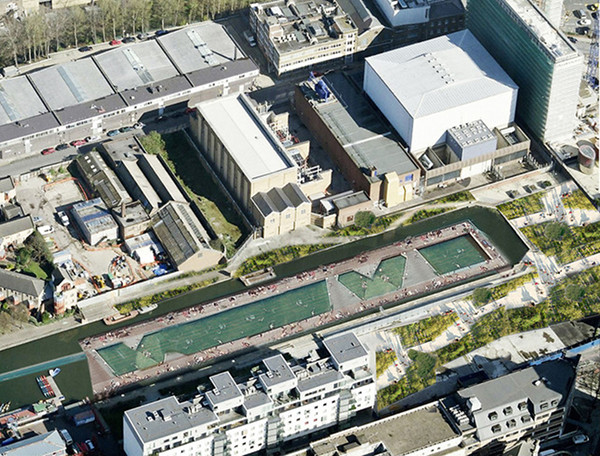When it comes to the adaptive reuse of defunct industrial infrastructure in cities, New York City’s High Line set the bar high — literally. Now, cities everywhere are seeking to emulate New York’s success on this front with High Line-inspired projects of their own, as evidenced by a recent conference and open ideas competition hosted by the mayor of London and the city’s Landscape Institute.
The competition in the High Line for London competition was both fierce and startling. Entries shortlisted for the £2500 first prize include a proposal to make use of the many empty roof spaces on top of bus shelters with raised gardens and sparrow colonies, insect hotels and miniature wildflower meadows, and a proposal to create a linear park, farm and wetlands on floating barges at the edge of Canary Wharf. But the first place prize, announced on October 8, went to architect Fletcher Priest Architects for a Pop Down, a proposal to create a mushroom farm beneath the city streets.

Said mushroom farm would occupy the now-defunct ‘mail rail’ tunnels beneath Oxford Street, which were once used to deliver the mail to the major stores in the area. According to the Landscape Institute, the judging panel — which included Joshua David and Robert Hammond, co-founders of New York’s High Line, Dr Penelope Curtis, Director of Tate Britain, Mark Brearley, Head of Design for London, and leading landscape architects Kim Wilkie and Jo Gibbons — were so impressed by the quality of the proposals shortlisted for the prize that they not only selected a runner-up (which was apparently somewhat of an unplanned thing) but nominated three highly commended designs.
Interestingly enough, New York has a bit of its own High Line-inspired proposal in the works that bears real similarities to the winning proposal in the High Line for London competition. That proposal is the Low Line (also known as Delancy Underground), which would take an old, defunct former trolley terminal beneath the Lower East Side and turn into a green park, using fiber optics to filter sunlight below-ground. That proposal appears to have gained traction over the past year, as it has garnered many of the verbal approvals required for its construction and the blessing of the MTA, which owns the site. Recently, proponents of the park built a working model of the Low Line in an abandoned warehouse on the Lower East Side.
The winning entry in the High Line for London competition likewise takes advantage of unused urban space underground, and likewise uses fiberoptic technology to filter light below ground level. This mushroom farm amongst the forgotten network of tunnels under London would be illuminated through a series of sculptural glass-fiber ‘mushrooms’ at street level. The designer sees this network as offering visitors the opportunity to embark on an expedition underground, entering and exiting the tunnels from street level. The mushrooms produced by this urban agriculture systems would serve pop-up concept ‘Funghi’ restaurants and cafés at each entrance.
Which, you have to admit, is a pretty cool idea. But so is the proposal that wound up being chosen as the runner up: the The Lido Line by [Y/N] Studio, a proposal to insert a clean, safe ‘basin’ in the Regent’s Canal that would allow hardy Londoners to swim to work from Little Venice to Limehouse in the summer, and commute via ice-skates in the winter.

More on the shortlisted entries is available online.